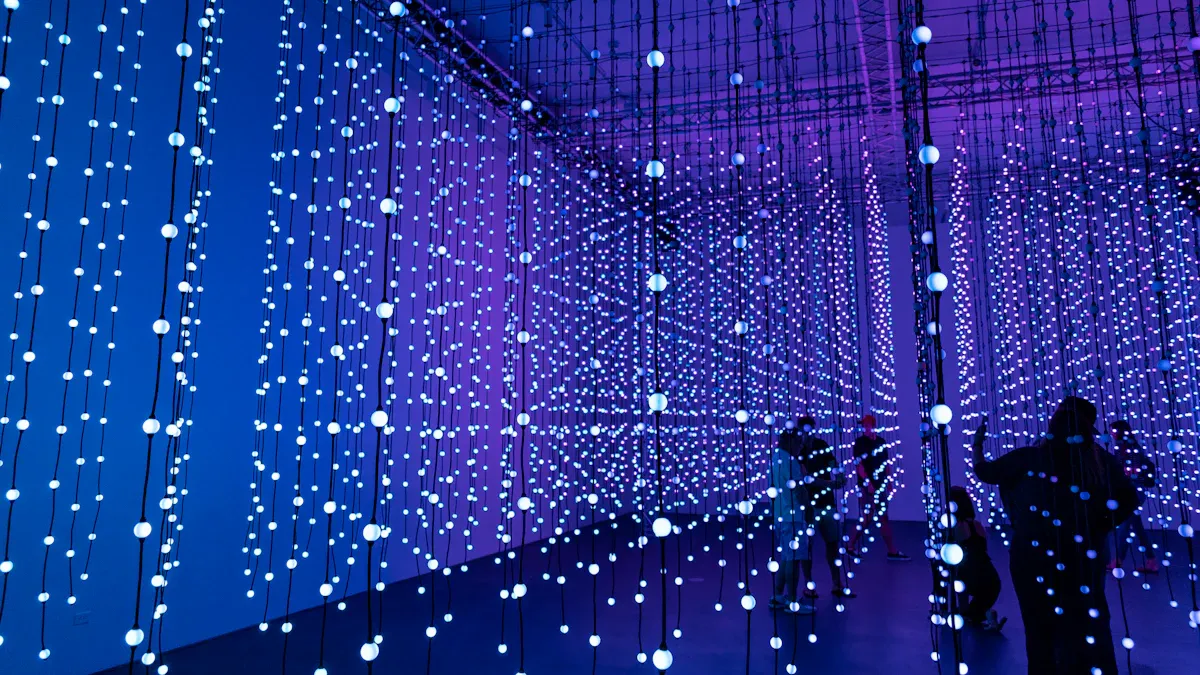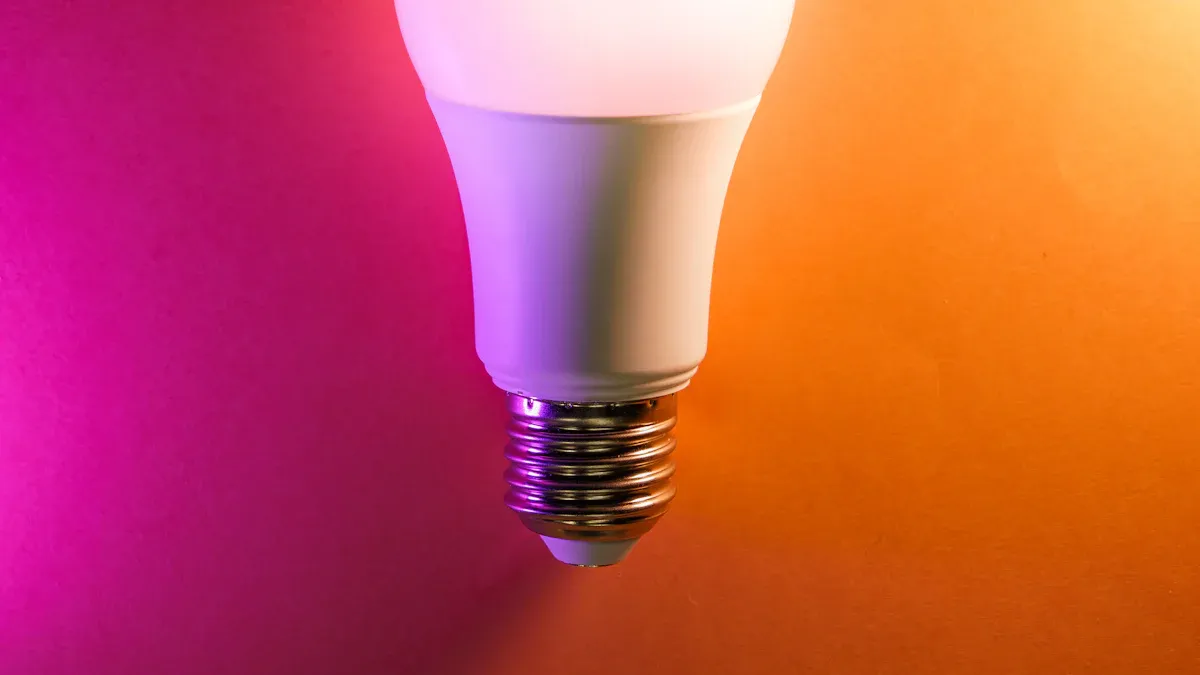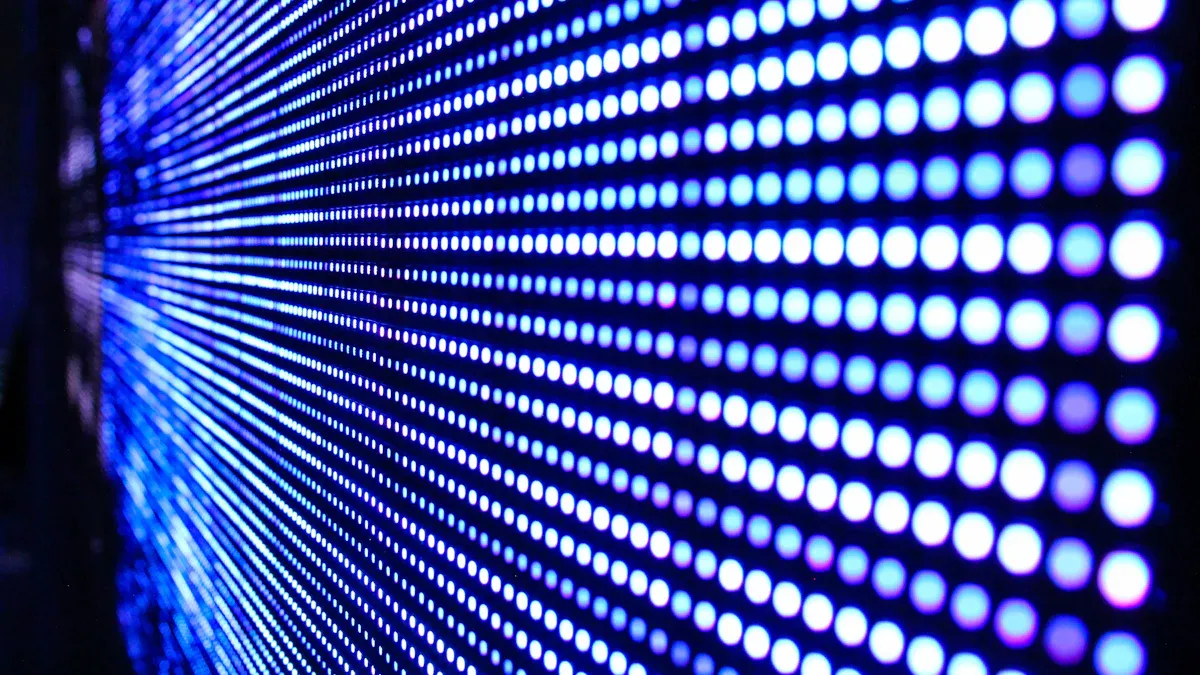LED Illumination Systems for Display Purposes

LED illumination systems use light-emitting diode technology to give bright and steady lighting for displays. Most new display systems use LED illumination systems because they last more than 50,000 hours. They are strong and can handle changes in temperature and shaking. Light-emitting diode illumination systems make displays look better with bright colors and clear pictures. These illumination systems also help lower maintenance and energy costs. They use less energy than older lighting types. Studies show that light-emitting diode illumination systems can break from heat or turning on and off a lot. But they still work better than old lighting. More than 60% of digital signage displays now use LED illumination systems to make displays look better.
Key Takeaways
LED illumination systems give off bright, clear light. This makes displays look better. They use less energy and last longer than old bulbs.
Picking the right LED type and fixture is important. You can choose edge-lit or direct-lit systems. This helps match what the display needs for brightness, size, and design.
Good LED panels and controllers help you change brightness and colors easily. This makes displays flexible. It is easy to update them with new images or effects.
Good lighting design uses smart controls and careful placement. This cuts down glare and saves energy. It also makes displays easy and comfortable to look at.
LED systems save money over time. They lower maintenance and energy costs. They are also better for the environment because they last longer and use less energy.
LED Illumination Systems
Types
LED illumination systems have different types for different displays. The way the light is placed changes how the display looks.
Edge-Lit LED Systems: These systems put the light on the sides of the display. A special plate spreads the light across the screen. This makes the display thin and light. People use these in slim TVs, laptops, and phones. Edge-lit systems use fewer LEDs, so they save energy. But sometimes the edges look less bright and the contrast is not as good.
Direct-Lit LED Systems: These systems put the light right behind the screen. A plate helps spread the light evenly. Direct-lit systems give better brightness and picture quality. They can dim parts of the screen for better contrast. These displays are thicker and use more LEDs. They work well for gaming, professional monitors, and fancy TVs.
Backlit Displays: Many new displays use a backlight behind the screen. This gives even light and bright pictures. Backlit displays can use edge-lit or direct-lit LED systems.
Portable and Battery-Powered LED Solutions: Some displays use LED lights that run on batteries. These are easy to move and set up. Battery-powered LED track lights can last 3 to 6 months. They are as bright as regular bulbs. Smart power features help save energy. Rechargeable batteries make them better for the environment.
Flexible LED Solutions: Flexible LED systems use bendy boards. These can make cool shapes and patterns. People use flexible LEDs for ads, signs, and decorations.
LED Technology Types:
SMD (Surface-Mount Device): These LEDs go right on the board. This makes small displays with clear colors. SMD LEDs work inside and outside.
DIP (Dual In-line Package): This older type has two pins. DIP LEDs are very bright and tough. They are good for outdoor displays that need to handle weather.
GOB (Glue on Board): A clear gel covers the LED parts. This keeps out dust, water, and bumps. GOB LEDs are used in displays that move a lot.
COB (Chip on Board): Many tiny LED chips sit on one board. This makes a bright and small light. COB LEDs stay cool and keep colors even. They are great for indoor displays with lots of detail.
Tip: Pick the right LED illumination system for your display’s job, how bright it needs to be, and the design you want.
Comparison Table: Edge-Lit vs. Direct-Lit LED Systems
Aspect | Edge-Lit LED Systems | Direct-Lit LED Systems |
|---|---|---|
LED Placement | LEDs on the sides, plate spreads the light | LEDs behind the screen, plate spreads the light |
Thickness | Thinner design | Thicker design |
Brightness Uniformity | Edges may look less bright | Even brightness everywhere |
Contrast & Local Dimming | Not much contrast or dimming | Better contrast and dimming |
Power Efficiency | Saves more energy | Uses more power, but better color and brightness |
Cost | Costs less | Costs more |
Ideal Applications | Slim TVs, laptops, phones | High-end displays, HDR, pro monitors, gaming |
Picture Quality | Lower contrast, brightness not even | Better picture, more even and higher contrast |
Fixtures and Applications
LED lighting systems use many fixtures for different displays. Each fixture has special uses for displays.
LED Fixture Type | Description & Typical Applications |
|---|---|
LED Strips | Bendy boards with LEDs. Used for shapes, letters, and patterns. Found in furniture, ads, bars, malls, and restaurants for decoration. |
LED Spotlights | Focused lights for showing off items. Used in malls, museums, and shows. |
LED Floodlights | Bright lights for big spaces. Used outside, in gardens, and large rooms. |
LED Downlights | Lights in the ceiling or on top for even light. Used in shops, stores, and offices. |
LED Panel Lights | Flat lights for even lighting. Used in offices, malls, and hospitals. |
LED Track Lights | Moveable lights for special spots. Used in shows, galleries, and hotels. |
LED Pendant Lights | Hanging lights for decoration. Used in bars, restaurants, and malls. |
Underground/Inground Lights | Small lights in the ground for decoration or direction in malls and parking lots. |
Wall Washer Lights | Give smooth light over big walls. Used for building lights and making outlines. |
LED wall washers and architectural lights are important for displays. They give smooth light on big areas and remove harsh shadows. This makes spaces look open and bright. Wall washers show off textures and shapes. At night, buildings stand out. You can change the color and brightness to make cool effects.
LED illumination systems last a long time and are very reliable. Most LED fixtures work for 25,000 to 100,000 hours. This is much longer than old bulbs. You do not need to change them often, so you save time and money. LED lighting also uses less energy, so it is smart for displays inside and outside.
Note: LED lighting systems make less waste and cost less to keep up because they last longer than old lights.
LED display systems use these fixtures and types to make displays bright, reliable, and save energy. The right mix of light, fixture, and system makes every display look great and easy to care for.
Components

LED Panels
LED panels are the main lights in most new displays. Each panel has many small LEDs that shine bright, even light. Good LED panels use new tech to stop flicker and glare. This helps your eyes feel better, even after looking for a long time. Some panels have special chips and coatings to keep the light steady. These things help stop headaches and eye strain. LED panels can show many colors and get very bright. They work well for displays inside and outside. The panels last a long time and do not need much care. They also use less energy than old lights.
Controllers
Controllers are like the brain for the LED system. They control how the lights work in the display. You can use controllers to change brightness, color, and effects. Many controllers let you use a remote or app to make changes. This means you can adjust the display from anywhere. Some controllers can run many screens at the same time. They let you use split screens and cool lighting patterns. Controllers help save energy by dimming the lights when you do not need them bright. They keep the LED system working well and make the display easy to use.
Optical Elements
Optical elements help shape and guide the light from LEDs. Lenses, reflectors, and diffusers all do different jobs. Lenses can spread the light wide or focus it in one spot. Reflectors bounce the light so it covers the whole display. Diffusers scatter the light to get rid of harsh shadows and make the light even. These parts help the display look smooth and clear. They also cut down glare and make the light easier to look at. Good optical elements make the LED display look better and help it stand out.
Note: Using good LEDs and optical elements gives you light that does not flicker or glare and is easy on your eyes.
LED Display System

Direct View LED Display
A led display system uses lots of small leds to make pictures and videos. In a direct view led display, each pixel is made from one led or a group of leds. This setup does not need an LCD panel or a backlight. The leds themselves make the images you see. This gives the led display system brighter light, better colors, and stronger contrast than older displays.
Aspect | Direct View LED Display System | Other Display Technologies (LCD, LED-backlit LCD) |
|---|---|---|
Pixel Structure | Each pixel is a group of leds that shine directly | Uses leds for backlighting behind an LCD panel |
Brightness & Contrast | Very bright, strong contrast, and bold colors | Not as bright, less contrast |
Size & Shape | Can be any size or shape, no seams | Only certain sizes and shapes |
Visibility | Easy to see in sunlight and bright places | Hard to see in strong light |
Maintenance | Simple to fix with panels | Harder to fix and keep up |
A led display system with direct view led display tech can reach contrast ratios of 3000:1 or higher. Each pixel mixes red, green, and blue leds to show many colors. This makes the led display system great for big screens, stadiums, and outdoor signs. The system also lasts longer and uses less energy than LCD displays.
Customization
A led display system lets you change lighting and effects in many ways. Each led in the system can be controlled by software. This lets people make animations, moving words, and special light patterns. The led display can show custom pictures, logos, and even videos.
Each led pixel can be set for color and brightness.
People can upload their own graphics, words, and animations.
Mobile apps and remotes make it easy to update the led display.
Programmable leds can show up to 16 million colors for cool effects.
The led display system can be made to fit any shape or size.
High brightness in a led display system keeps pictures clear, even in sunlight or bright rooms. Good color makes images look real and sharp. Outdoor led display systems use high brightness and strong contrast to stay easy to see from far away. These features help businesses, stadiums, and cities share messages and ads that people can see any time of day.
Tip: A led display system with high brightness and good color is great for outdoor signs, digital billboards, and event screens. It keeps pictures sharp and easy to see, even when the light is tough.
Illumination System Design
Energy Efficiency
Designing an illumination system helps save energy and money. Designers pick the right fixture for each job. Task lighting uses focused light for work. Ambient lighting spreads light all over a room. Dimmable LEDs let people change how bright the light is. Adjustable color temperatures help set the best light for each task. This makes the system use less energy and feel better to use. Smart controls like sensors turn lights on or off when people move or when it gets bright outside. These features stop energy waste and help the system last longer.
A good illumination system gives lots of light but does not use much power. Lighting calculators help check how much light each space needs. Designers also look at natural light so they do not use too many lights. Cleaning and taking care of the system keeps it working well. After setting up, people watch energy use and light quality to make the system better over time.
Tip: Brightness control in led lighting systems lets people turn down the lights when they do not need them bright. This saves energy and makes rooms feel nicer.
Placement and Optimization
Putting lights in the right place stops glare and harsh light. Designers do not put lights where people look straight at them. They point fixtures to light up displays but not shine in eyes or on shiny things. Anti-glare bulbs and diffusers make the light softer and safer.
A good system spaces lights about 1.5 times higher than where they are mounted. This gives even light and stops bright spots. Picking the right color temperature, usually from 4000K to 5000K, makes displays look clear. Checking for dust or damage often keeps the system working well.
Designing a lighting system also means picking smart controls and easy ways to use them. These choices help people make the lighting effects they want. Simulation tools let designers test how lights will look before putting them in. Careful planning gives better results and makes displays more fun to see.
Benefits for Displays
Longevity
LED illumination systems help displays last a long time. Most LED lights work for 25,000 to 50,000 hours. This is much longer than old lights. The table below shows how long each type lasts:
Lighting Technology | Average Lifespan (hours) |
|---|---|
Incandescent Bulbs | ~1,000 |
Compact Fluorescent Lights | 8,000–10,000 |
LED Lights | 25,000–50,000+ |
LEDs do not stop working all at once. They slowly get less bright over time. This helps displays stay working well. Good cooling and strong parts help LEDs last even longer. In digital signage, this means less fixing and lower costs. Businesses with LED billboards or led video walls save up to 75% on repairs. They also save 30-50% on energy, so they get their money back fast. For example, a warehouse using LED signs saved 93% on energy bills. LED tvs and digital billboards need fewer new parts and use less power.
LED lighting makes less trash and is better for the planet because it lasts longer than old bulbs.
Flexibility
LED illumination systems let designers make many kinds of displays. They can use smart controls, bendy panels, and new ways to build them. This helps fit any space or shape. The table below shows why LEDs are so flexible:
Factor Category | Description | Contribution to Flexibility and Scalability |
|---|---|---|
Smart Control Systems | IoT and sensors for adaptive lighting | Dynamic adjustment for different needs |
Manufacturing Advancements | Micro-LEDs, 3D printing, quantum dots | Custom shapes and scalable production |
Fully Organic LEDs (FOLEDs) | Thin, bendable, lightweight panels | Curved or irregular displays and advertisements |
LED billboards in busy places show moving ads that change fast. Led video walls at concerts and shows make bright, moving backgrounds. Digital signs in stores use color-changing LEDs to show off products. Designers can bend, stack, or shape LED displays for cool ads and signs. This helps brands get noticed and connect with people in crowded areas.
LED illumination systems make it simple to change content, set brightness, and make displays look exciting.
LED illumination systems last a long time and save energy. They make displays look bright and clear. You can use them in many ways. These systems help displays work better and show good pictures. When picking a led system, think about what your project needs. Make sure the colors look real and bright. Plan how you will set up the system. Clean the display and check wires often. This helps the led display work longer. Plug & play led choices are simple to install. They work in lots of places. The best led system gives you a bright display that works well and does not cost too much.
Key Factor | Description |
|---|---|
Project Needs | Pick the right led for your display |
Color Accuracy | Make sure colors look bright and real |
Installation | Set up easily and make sure it fits |
FAQ
What makes LED illumination systems better than traditional lighting for displays?
LED illumination systems use less energy and last much longer than old bulbs. They give bright, even light and need little maintenance. Many stores and businesses choose LEDs because they save money and make displays look sharp.
Can LED display lights work outdoors?
Yes, LED display lights work well outdoors. They resist rain, dust, and sunlight. Outdoor LED systems use strong materials and special coatings. These features help them last longer and stay bright in all weather.
How do you control the brightness and color of LED displays?
Controllers let users change brightness and color easily. Many systems use remotes or apps. Some displays have smart sensors that adjust light based on the room. This helps save energy and keeps displays looking their best.
Are LED illumination systems safe for the eyes?
LED systems with good diffusers and no flicker are safe for the eyes. They reduce glare and eye strain. People can look at these displays for a long time without feeling tired. Always choose high-quality LEDs for comfort.
See Also
Understanding The Basics Of LED Light Box Displays
Exploring The Innovations In LED Digital Display Technology
A Comprehensive Guide To LED Sign Types And Technologies
Integrating Digital Solutions With LED Display Signage Effectively

